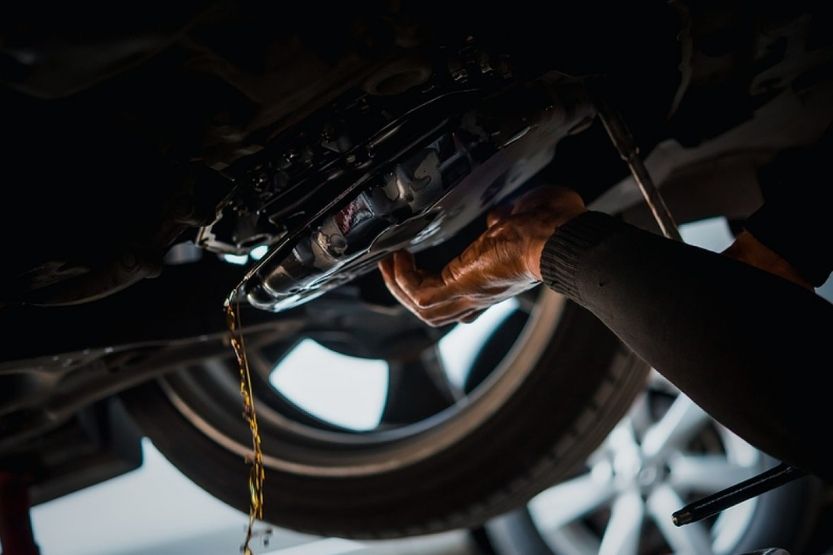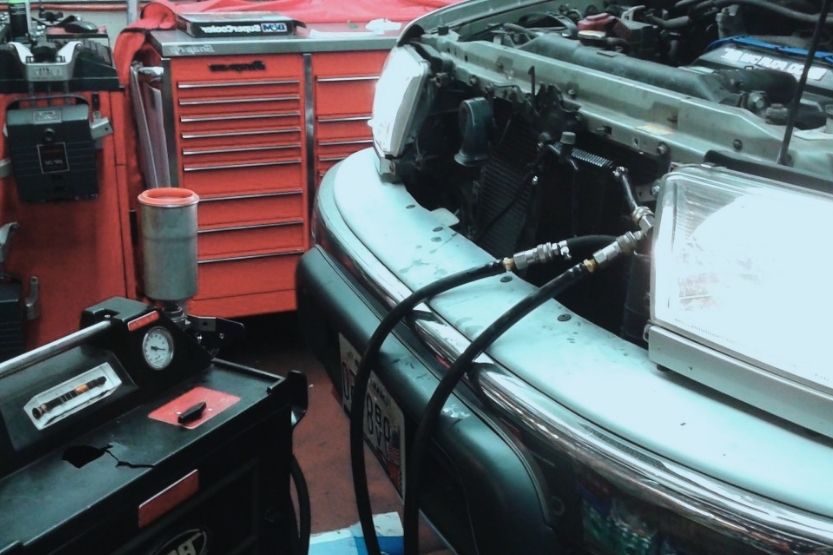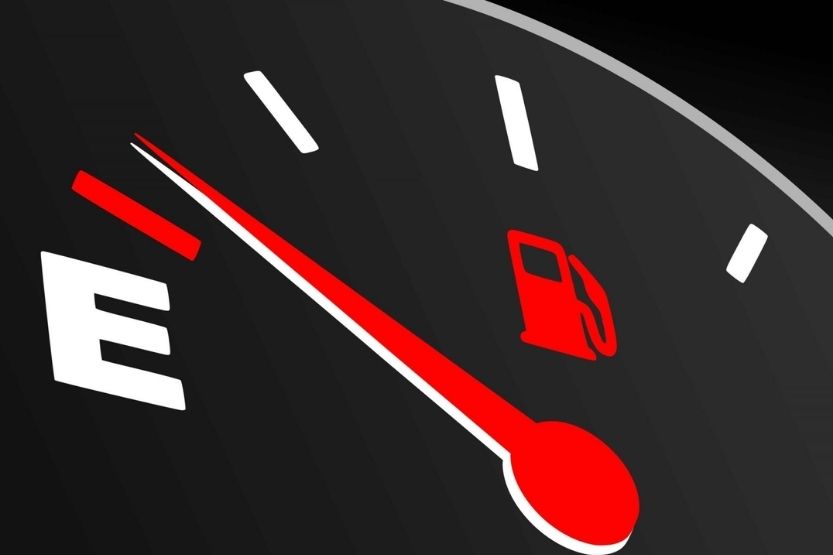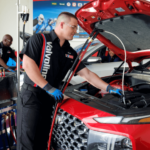A transmission fluid change and a transmission flush are two common maintenance procedures for a car. But are they the same? What is the difference between a transmission fluid change and a flush?
A transmission fluid change and flush are two different services. A transmission fluid change involves draining the dirty fluid from the pan, while a transmission flush removes all the fluid in the pan and the torque converter.
Read on to learn more about the difference between a flush and fluid change.
What Is a Transmission Fluid Change

Transmission Fluid Lubricate and Cool the Necessary Parts
Repairs for transmission consume not only much time but are also costly. Nevertheless, with basic maintenance, you can save money and time. A car’s transmission depends on the transmission fluid to lubricate and cool the necessary parts.
Transmission Fluid Change Gets Rid of System Buildup
You will likely see your car’s manual transmission fluid change as the solution for all transmission services. A transmission fluid change gets rid of a huge amount of system buildup.
A mechanic will drain the fluid from your transmission, replace the filter, and refill your transmission with new fluid.
First Step in a Transmission Fluid Change
The primary step in this process is the replacement of the filter. As the name suggests, a filter removes all the contaminants in the fluid before it reaches transmission.
It would be best to keep in mind to have the filter replaced by a professional. Doing this will prevent issues in shifting gears, slipping gears, car surging, and grinding noises from your transmission.
Replace the filter at least every 20,000 to 40,000 miles for optimum functionality. Moreover, you will likely not have driving problems and lessen the possibility of driveability issues.
Manual Vs. Automatic Transmission Fluid Change
For manual transmission, changing fluids means completely draining and replacing all the oil. Nevertheless, only half of the fluid is refueled in the process for automatic transmissions. The other half remains in the torque converter and cooler.
You will find the torque converter between your transmission and the engine. It has four parts: a stator, converter clutch, impeller, and turbine.
It is crucial to maintain your torque converter in optimal condition because it prevents the following:
- Active Check Engine Light or transmission light,
- Leaks,
- A strange noise,
- Slipping transmission, and
- Shaky Car
Though the automatic transmission only changes half of your car’s fluid, this is a better option than not changing it.
Some Mechanics Recommend Gradual Transmission Fluid Change
Rather than completely changing your fluid, some mechanics recommend changing the fluid gradually. With transmission fluid change, your mechanic can see the filter and pan.
After the fluid drains, the pan, found at the base of the transmission, is removed. If metal debris or particles are in your pan, it can be a sign that there is an issue that needs to be repaired.
Ideal as a Preventive Maintenance
A transmission fluid change procedure is almost painless and fast. Moreover, your mechanic can have many ways to assess the overall health of your transmission. It is ideal if you want simple yet preventive maintenance for your transmission.
Advantages of a Transmission Fluid Change
Here are the top benefits of transmission fluid change:
1. Better Fuel Economy
One of the major advantages of regularly changing your fuel is having a better fuel economy. You need to replace your fluid if it becomes black. That is because this ensures that your transmission operates more smoothly and your engine works better.
2. No Locking-Up of Engines
You risk your engine locking up if you do not replace your fluid. This can result in your transmission working too much that it can shut down. You can prevent this problem by regularly replacing your fluid.
3. Save More Money
You will not need to pay for costly repairs or replacement of your malfunctioning or broken transmission if you opt to change your fluid regularly. Replacing your transmission is one of the priciest services you get from mechanics.
You might need to spend between $1,800 to $3,400 to have your transmission repaired. You can prevent major car maintenance problems when you replace your fluid regularly and follow the duration provided by your mechanic.
4. Smoothly Running Car
When you boost your transmission fluid, you can avoid damage. Therefore, you are ensured that your car functions optimally. This results in a better driving experience and oil and fuel efficiency.
What Is a Transmission Flush

Does Not Require a Mechanic
The process of transmission flush began more than two decades ago. The idea is that automatic transmission change can be done using a machine.
This was a major technological breakthrough during this time. Since no mechanics are needed, you can save more money. As a result, many car repair shops purchase said machine to save labor and money.
Fill up the Amount of Transmission Fluid Needed
The process of transmission flush is somewhat basic and strictly follows the steps. First, you must fill up the needed amount of transmission fluid and connect it to the transmission lines.
Cost
Then, you operate it. The previous fluid and smudge will be cleared, and the new fluid will be refilled simultaneously. You can put a solvent through the transmission if you see that the lines are dirty. A flush can cost about $75 to $150.
Again, what is the difference between transmission fluid change vs. flush? A transmission fluid change involves draining the dirty fluid from the pan. Meanwhile, a fluid flush involves removing and replacing the fluid in the pan, cooler lines, and torque converter. Fresh transmission fluid ensures cooler transmission and its protection from wear and tear.
Advantages of a Transmission Fluid Flush
The benefits of transmission flush vs. change include:
1. Clean Transmission Fluid
Because there is a possibility that your transmission fluid deteriorates in the long run due to collected debris, this can affect the efficiency and functionality of your transmission.
The expenses can be hefty to your car if there is debris in the fluid because it affects how your transmission lubricates. A full flush can get rid of all the debris and decomposed fluids.
2. Cleans Out the Rust from the Transmission Elements
Although you need coolant to prevent your engine and transmission from freezing due to frigid weather, it can cause corrosion to your transmission. It can rust the tubing and clog the conduits with debris over time.
You can clean out the rust completely and ensure your engine functions optimally by doing a transmission flush.
3. Prevent Cars from Malfunctioning
There can be overwhelming damage to your transmission if you do not regularly replace your transmission or flush your system. This can result in your engine functioning at a lower quality in the long run. This can lead to an overheating engine and your car becoming unusable.
4. Having Better Lifespan for Your Transmission
When you regularly maintain your transmission, you can improve the quality and longevity of your car. It would be best if you do a standard transmission flush for every 40,000 miles so that you can remove rust and debris and avoid exposing your car to too much damage.
Things to Remember When Considering a Transmission Flush
You likely have understood that a transmission flush procedure is simple. However, a transmission flush is more expensive than a transmission fluid change since a machine is needed for the latter.
Some shops can ask for a higher price than average since they want their money back fast for the machine needed in flushing. Be careful when dealing with these mechanics because they can automatically offer a transmission flush as a solution.
Another thing is that a transmission flush does not require the filter to be replaced or the pan to be taken away. So, the mechanic won’t be able to if there is any damage or debris in the filter.
There’s also a possibility of transmission seal damage due to the high pressure from the machine.
Why Does Your Vehicle Need Transmission Service?

Here are the reasons why transmission maintenance is important:
1. Prevents Overheating
Particles in the transmission and metal shavings can be collected and settled inside your transmission fluid after a long time. The fluid and transmission can be heated a lot when the fluid moves—the hot fluid results in burning the particles and overheating the internal parts.
Your transmission has chemical components that allow your gears to lubricate and change. Nevertheless, these components concentrate on removing heat. The friction in the transmission creates an extraordinary amount of heat that can damage your car.
The heat breaks the compounds in the fluid over time and causes it to lessen the heat the fluid can deliver to other moving parts.
The ideal temperature of the fluid is about 175°F. If it goes beyond 200°F, overheating happens, and problems worsen whenever there is an increase of 20°F.
2. Better Gear Operation
Proper transmission maintenance can result in better operation and efficiency of your car’s gears. Shifting is hard when your transmission starts to overheat. That is because the fluid becomes a thick sludge that clogs the gears.
3. Better Fuel Efficiency
When your transmission operates at a rate lower than normal, there is less pressure and strain on the moving parts of your car. The wheels have more energy when the friction created by the rotating parts is low. As a result, there is an improvement in fuel efficiency.
Transmission Fluid: Why Is It Important
There are many different parts to your transmission system. These produce heat and have to be cooled and lubricated constantly to have fewer chances of overheating. The one that spreads heat through a cooler is your transmission fluid.
Moreover, transmission fluid maintains the smooth functioning of your transmission since it lubricates the important parts.
Transmission fluid is also important in automatic transmission because its pressure gets specific gear ratios. Your fluid can deteriorate and accumulate particles, losing its lubrication abilities.
What Is the Difference Between Transmission Flush Maintenance and Repair?
All car owners should know that a car transmission flush and a repair are different. Although doing a transmission flush provides much help in preventing transmission problems, there is no assurance that it can repair or fix anything.
Many transmissions do not succeed even after a transmission flush. The reason for this is not the flush itself. It is due to the transmission that is almost close to breaking down.
Although you should not have expectations for a transmission flush to repair, you are guaranteed that it can help in keeping the quality. You will not be able to use your car for a long time without a working transmission.
That is why you must ensure that you maintain your transmission is working its best to avoid debris in your oil and obstructing the filter.
Conclusion – Transmission Fluid Change Vs. Flush
So it is important to understand the difference between a transmission fluid change vs. flush. A transmission fluid change and flush are two different services. The former involves draining the dirty fluid from the pan, while the latter removes all the fluid in the pan and the torque converter.
Before bringing your car to your mechanic for a transmission service, you must understand their difference. Both have advantages and disadvantages. What is important is that you analyze them to make the right choice.

![What Is a Transmission Flush? [All About Transmission Flushes] what is a transmission flush](https://roadsumo.com/wp-content/uploads/2021/12/what-is-a-transmission-flush-150x150.jpg)
![Transmission Flush Cost [How Much Is It?] transmission flush cost](https://roadsumo.com/wp-content/uploads/2022/10/transmission-flush-cost-150x150.jpg)






